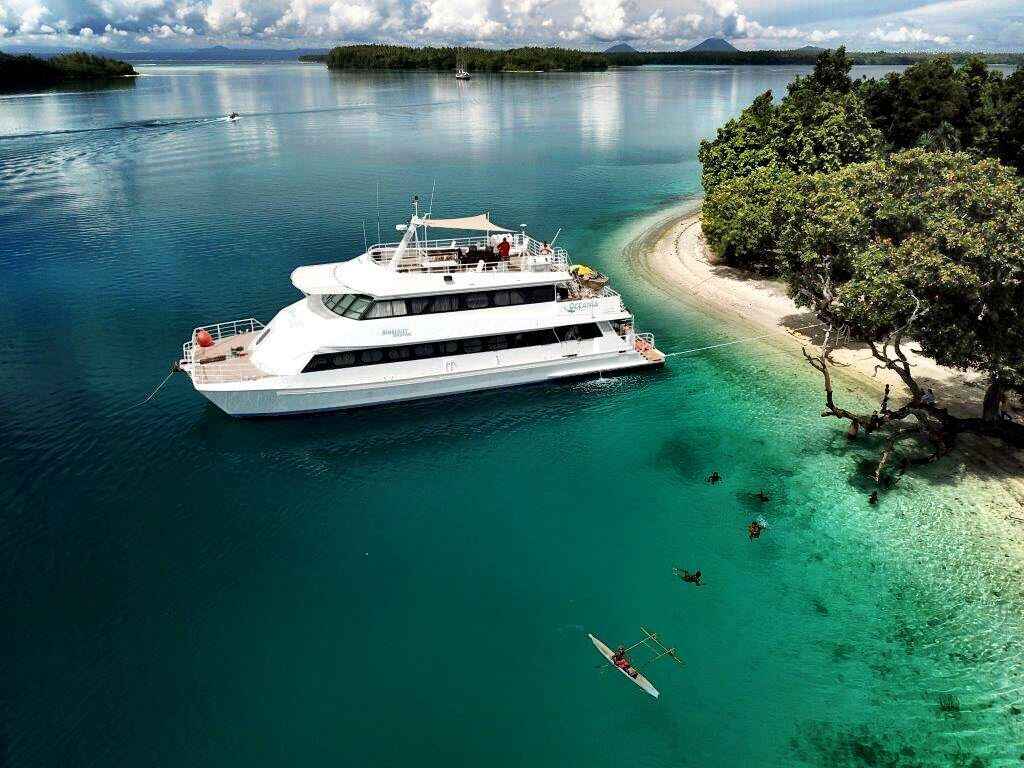Walindi Plantation Resort
Walindi Plantation Resort is located on the shore of Kimbe Bay on the island of New Britain and the home port of the liveaboard, Febrina and Oceania. Set on the grounds of an old coconut plantation, this resort makes for an idyllic spot to base yourself for some of the best diving on the planet. The variety of diving is simply outstanding. From pelagics to macro and reefs to wrecks, there is something here for everyone.
The main social hub of Walindi features an open tropical and airy reception area, Casuarina Restaurant, lounge and Planters Bar. There’s a swimming pool, sundeck, Blue Taro Boutique and library with computers to connect to the outside world. Wireless internet is available in the main resort area.
In addition to world class diving, Walindi also offers land tours including village visits, volcano and nature walks, and WWII artifact exploration tours. Walindi supports the local community through a variety of projects. Come find out why Kimbe Bay is one of the most magical places on our planet.
At Walindi, you will have two styles of accommodations to choose from.
Bungalows
There are 12 premium individual bungalows with private facilities, ceiling fans and large mesh screened windows. The bungalows are sprinkled along the beach side of the resort with the surrounding rainforest providing privacy. Constructed with local materials and thatched roofs, the bungalows are spacious and comfortable with all the comforts of home. 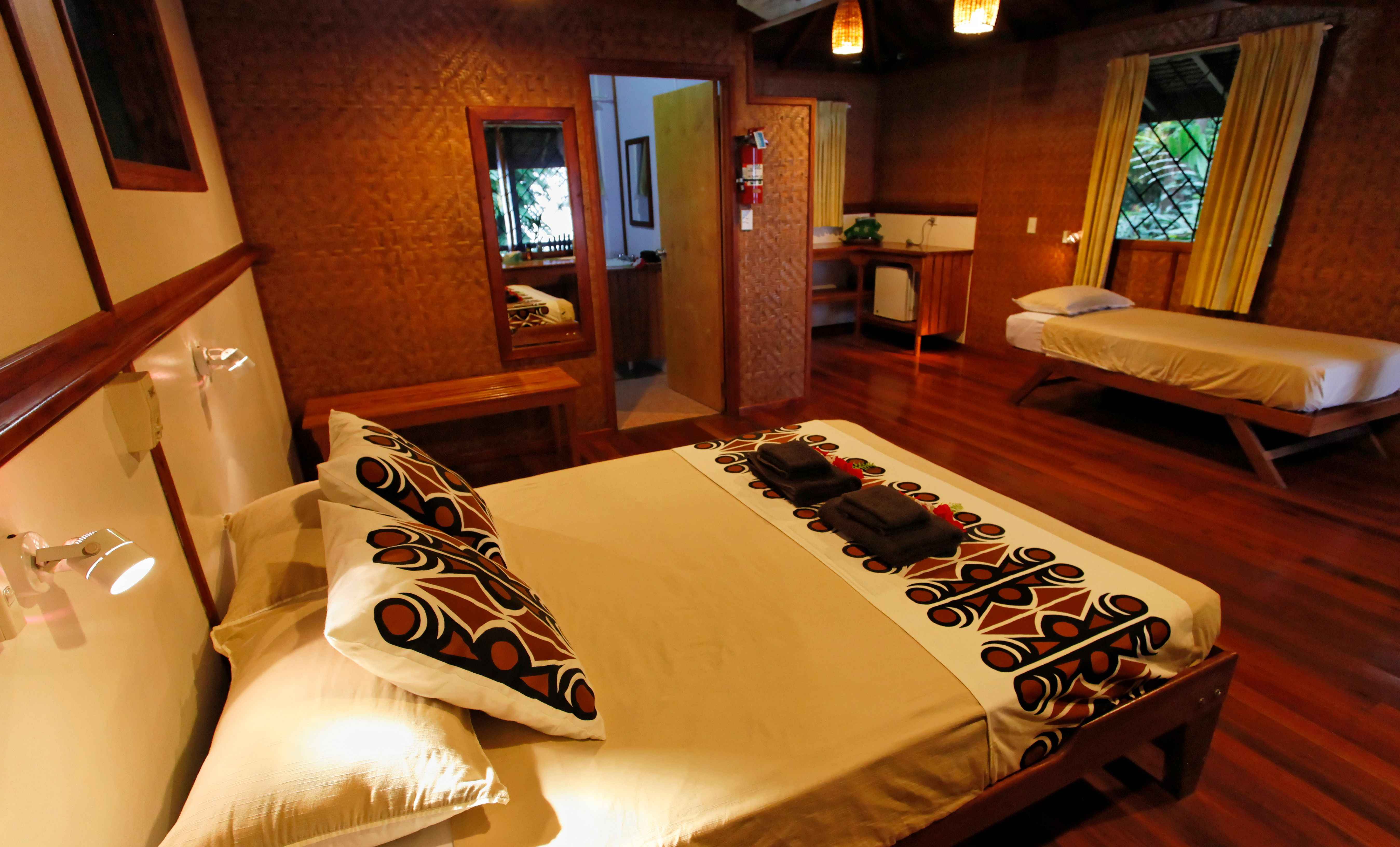
Plantation House
A less expensive option is the Plantation House Rooms which are smaller than the bungalows and located further back from the beach in the gardens. There are two buildings with 4 rooms each with a common verandah. Rooms have private facilities and similar amenities as the bungalows. 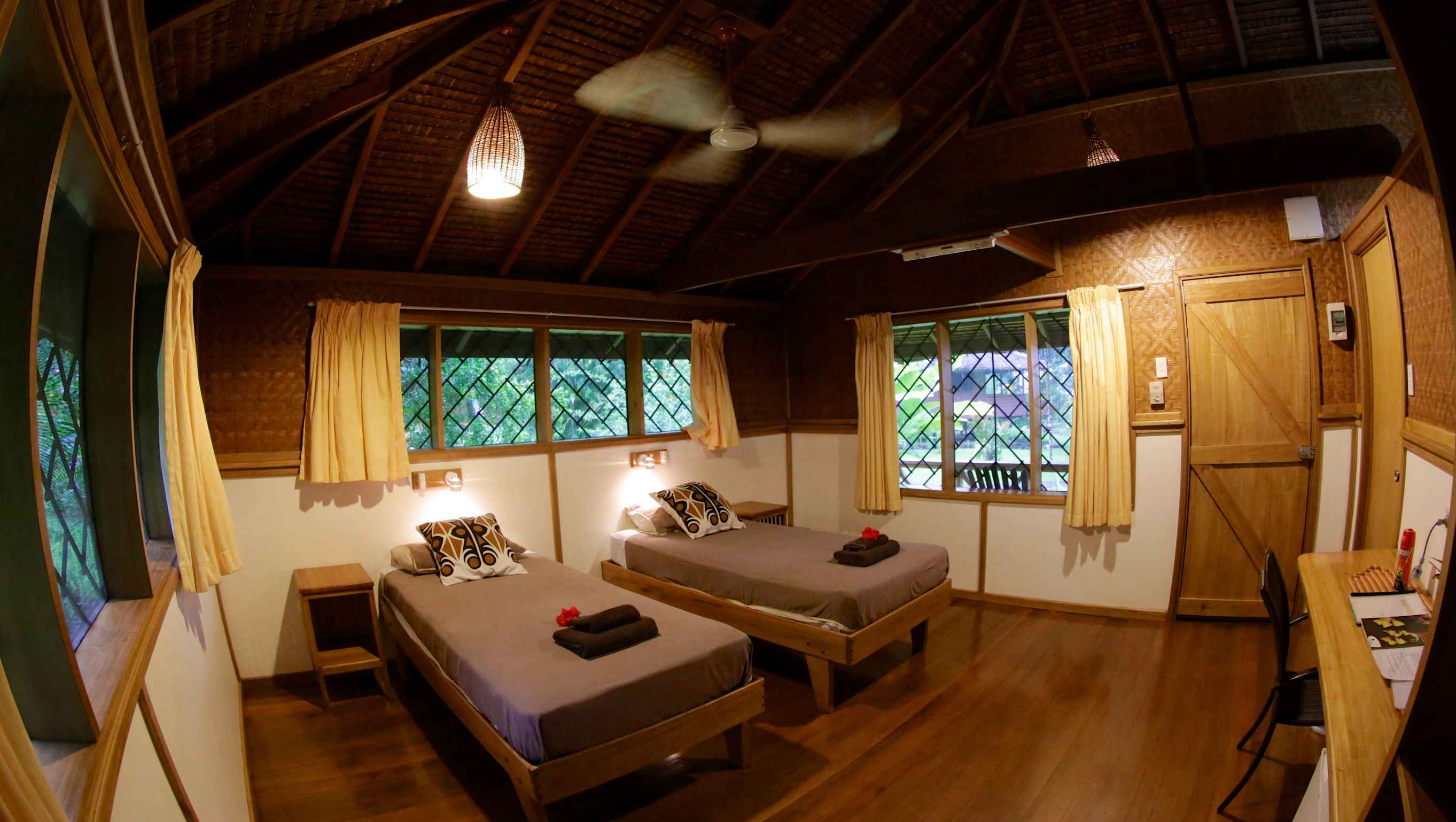
Diving!
Kimbe Bay is home to some of the healthiest coral, as well as some of the largest diversion of both coral and fish anywhere on the planet. Prof Charles Veron, former chief scientist of the Australian Institute of Marine Science had this to say - "The coral reefs of Kimbe Bay take me back forty years to a time when corals grew in lush profusion, untroubled by the problems that beset them today ..."
Walindi Resort dives over 40 reefs in Kimbe Bay. Below are brief descriptions for some of our favorite reefs around Walindi. We have listed some of the more interesting fish and critters that have been seen at the sites listed, but of course there are no guarantees that you will see them on every dive. What we can guarantee however, is that you will see vastly more than can ever be described in the brief overviews given here. Take your time and dive carefully, and you will be able to better appreciate what is one of the most diverse and healthy ecosystems on the planet.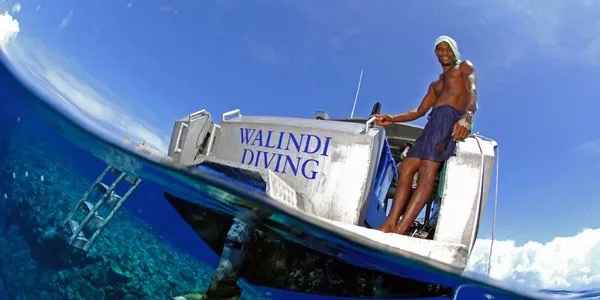
Susan's Reef
Dense stands of Red Sea Whips (Ellisella sp.) give Susan's Reef a unique aesthetic quality that sets it apart from other Walindi reefs. A stunning collection of corals is particularly rich at the southern end of the reef including large gorgonian fans, red sea whips and elephant ear sponges, everything adorned with colorful crinoids - a delight to all who dive here.
Inglis Shoal
Inglis Shoal rises from very deep water to within 11 metres of the surface and is very rich in fish life. Pelagic fish species are common and include Dogtooth Tuna, Barracuda and Bigeye Trevally. Scalloped Hammerheads and Grey Reef Sharks are sometimes seen at Inglis Shoal.
Restorf Island
The waters around Restorf Island hold an incredible diversity of marine life. It would be possible to spend a week diving here and still find new things in the various habitat types around the island. Depth is from the surface, down to 32 metres and this site is one of the many that are also excellent for snorkeling.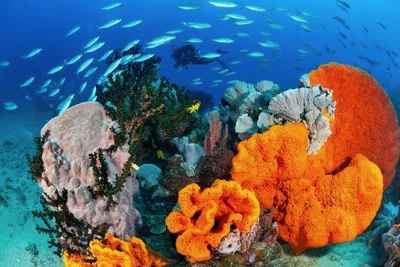
Christine's Reef
Christine's Reef is a collection of reefs joined by underwater ridges to form a large horseshoe shape complex. A photographer's paradies, Chirstine's features a beautiful collection of extremely large barrel sponges, many different gorgonian fan corals and red whip gorgonians. As with all Walindi reefs, reef associated fishes are abundant and diverse.
Otto's Reef
This large reef, being isolated from any other reef or land mass, is entirely different to any other Walindi dive sites. On days when the current is creating eddies on the point, schools of barracuda, trevally, sea perch, fusilier, unicorn fish and surgeon fish mix with a variety of shark species and tuna, resulting in plenty of exciting action.
Vanessa's Reef
Vanessa's is a submerged shoulder that extends westward off a much larger reef at a depth of fifty to sixty feet. It's primary attractions are a multitude of large dark red gorgonian sea fans and further out on the shoulder, a sponge garden featuring many huge elephant ear sponges, a few barrel sponges and bright orange sponge mounds.
South Ema Reef
If any dive site in Kimbe Bay can be said to have it all, it would have to be South Emma. Huge barrel sponges, red whip gorgonians, colourful soft coral and a deep swim through cave are just a few of the attractions. The crest of the bommie is covered in hard corals with occasional sea anemones. Fusiliers, trevally and sometimes barracuda cruise the waters above the bommie.
Hanging Gardens
This site is situated along a sheer vertical wall starting from just below the surface and descending to a depth of about ninety feet. Along the wall are numerous ledges and overhangs and the site is named for the many tangles of rope sponge hanging down along the face of the wall. An excellent choice for a night dive when many of the nocturnal animals that hide in the caves and crevices come out to forage.
Joy's Reef
Joy's is a hard coral reef that slopes downward from the surface to a sandy floor at about eighty feet. Sand channels cut downward through the reef to meet the sandy floor and these gullies are excellent places to hunt for sand burrowing gobies such as the Twinspot Goby and shrimp gobies The walls that bound the reef slope are particularly lush with black corals, gorgonians, sponges and ascidians.
Paluma Reef
The dive site at Paluma reef is a deep underwater plateau, joined to the main reef by a descending shoulder. The primary attraction of Paluma is it's large number of lavender, pink and yellow Dendronephthya soft corals, some of which are a metre tall. While not as numerous as some other reefs, there are angelfish, butterflyfish, damselfish, fairy basslets and at least three species of anemone fish.
Snorkeling with Walindi
Kimbe Bay with its warm, clear, calm waters and small rainforest covered islands offers a unique and ideal place for Snorkeling. A large number of Kimbe Bay reefs come close to the surface so are very well suited for snorkeling and is one of the few places in the world where the snorkeling is at least as good (and possibly better in some areas) as the diving. Pristine and colorful corals are home to a variety of fish, crustacean and invertebrate life and many of the reefs have resident schools of barracuda, tuna and jacks. A range of shark species are regularly sighted particularly on the offshore reefs. Resident pods of dolphins frequently entertain snorkelers transiting between sites. The occasional sightings of orcas, pilot whales, whale sharks and other marine life passing through Kimbe Bay waters delight both guests and staff.
Walindi Plantation Resort has developed several exciting land tours exploring New Britain's rainforests, rivers, volcanoes and wildlife. For an adventure, hike up the local active volcano; for a more relaxing day visit the natural spa that is the thermal hot river; visit relics of the past with reminders of WW2; wake up early to see the sunrise and look for birds, spend the day at the local village, fly around Kimbe Bay on a scenic helicopter flight or stay up late and watch the natural lightshow of the local firefly trees. There is an adventure to suit all interests.
Community Engagement
The field of operations include many traditional resource owners and communities. Therefore, community consultation & engagement practices are central to the resort’s operation ethos allowing access to these natural wonders of Kimbe Bay.
Volcano Hike
A reasonably arduous hike uphill takes you up to the top of the active Garbuna volcano crater. The innumerable species of flora and fauna you will see in the rainforest on the climb up puts New Britain and the whole of Papua New Guinea on the top of naturalists’ and scientists’ lists. Starting just at the edge of Walindi Plantation, this trek takes you though lush pristine rainforest, where vast trees rise to form a dense canopy. The route will take you on a gentle climb through the rainforest to the crater on a bush track known only to local guides. On your way up keep an eye out for interesting insects, birds and plants. The route then comes out in the open scorched valley with steaming vents, volcanic rubble and hot streams. The hike up will take approximately three hours. The walk back down (along the same route) takes approximately two to three hours. The terrain is steep and can be slippery, but it is a wonderful way to see the Island from a very different perspective.
Hot River
Hidden in the West New Britain tropical rainforest runs a thermal river. It is a wonderful emerald green stream with swirling pools and mini waterfalls, fed by a volcanic spring. Due to its volcanic source, the river is naturally rich with minerals and high in sulphur, so a brief soak in its waters will leave your skin and hair feeling soft and silky smooth. The water temperature is around 43° Celsius (around 110° Fahrenheit). Take the opportunity to bathe in warm waters surrounded by rich rainforest and to feel completely rejuvenated, treat your body to a natural exfoliating treatment with the special red mud found along the riverbanks. For a truly unique spa session, the hot river is a must when visiting Walindi Resort.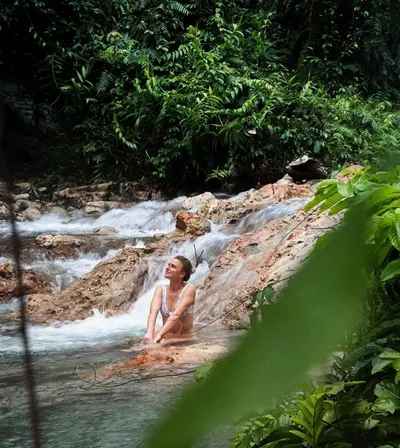
WWII Plane Wrecks
For anyone interested in plane wrecks or war history in general, the abandoned New Zealand 4522 Lockheed Vega Ventura and the American B-25H Mitchell Bomber are worth a visit. In 1944 the B-25H Mitchell crash landed due to engine trouble, damaging the front nose gear and the Lockheed Vega Ventura PV1 took a Japanese 25mm bullet through the starboard engine’s fuel line during a strafing run; both were considered irreparable and scrapped. A short drive to the north of Walindi, and guests can climb through the vine ridden historic aircraft that are considered the last in the world to have the original outfitting of artillery.
Fireflies
For a quick after dinner jaunt, you can visit the local firefly trees where you will encounter whole trees pulsing with the luminous fireflies - a truly amazing natural spectacle. Located on the very edge of Walindi Plantation Resort’s property, lies a collection of small trees that during the day looks like any other tree in the surrounding rainforest, but at night these trees come alive with thousands of tiny beetles called Fireflies. These minute beetles flash in synchronous or pulsing waves of light, a magic light show in the forest. It is not entirely known why they have chosen these trees and why they flash like they do but what is certain is it is a natural nocturnal spectacle worth seeing.
Helicopter Scenic Flights
Helicopter scenic flights are available with Niugini Helicopters and is one of the most exciting experiences we offer, flying over the islands of Kimbe Bay, the lush rainforest and pristine volcanic lakes including a low flyover of Gabuna Volcano. Up to 5 passengers can ride in the helicopter with pick up and drop off directly at Walindi Resort with options of 30 minutes or 1 hour flights.
New Britain Island Birdwatching
New Britain is a geological hotspot that holds many endemic species and contributes significantly to the avian diversity of the New Guinea region. A birdwatching tour to Papua New Guinea is not complete without a visit to the Bismarck Archipelago. Walindi offers the best location for exploring the north coast of New Britain and the Bismarck Sea in comfort. Tours are offered to nearby rainforests and small islets in Kimbe Bay for a host of exotic Bismarck and New Britain endemics. Exciting species include the Heinroth's Shearwater, Golden Masked Owl, New Britain Pitta, Nicobar Pigeon, Blue-Eyed Cockatoo, twenty pigeons and doves, nine kingfishers including the Black-Headed Paradise Kingfisher and a host of little known passerines.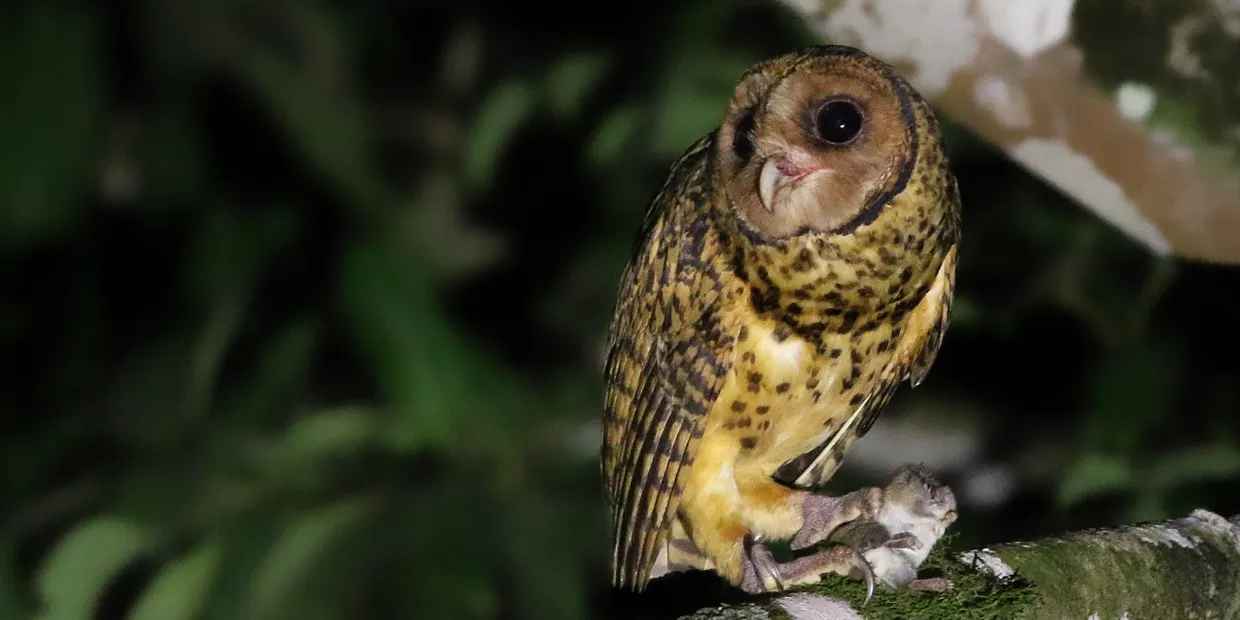
Exploring further afield
Papua New Guinea is located in the coral triangle, the centre of marine biodiversity which has the highest diversity of tropical fish and coral in the world. While on the liveaboards, guests will be diving on some of the most beautiful reefs and sea mounts in the Bismarck Sea, with abundant fish life amongst picturesque and dramatic volcanically formed reefscapes.
The dive liveaboards, MV FeBrina and MV Oceania, offer a variety of itineraries throughout the year tailored to suit changing weather patterns and designed to dive the best of what is on offer in Papua New Guinea. Kimbe Bay itineraries can be combined with your stay at Walindi Resort.